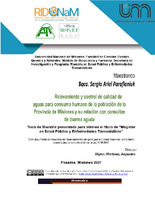| dc.rights.license | Licencia de Creative Commons Reconocimiento-NoComercial-CompartirIgual 4.0 Internacional (CC BY-NC-SA 4.0) | |
| dc.contributor | Martínez, Alejandro Ramón | |
| dc.creator | Parafieniuk, Sergio Ariel | |
| dc.date.accessioned | 2022-04-29T14:29:02Z | |
| dc.date.available | 2022-04-29T14:29:02Z | |
| dc.date.issued | 2020-12-15 | |
| dc.identifier.citation | Universidad Nacional de Misiones. Facultad de Ciencias Exactas, Químicas y Naturales. Módulo de Bioquímica y Farmacia. Secretaría de Investigación y Posgrado. Maestría en Salud Pública y Enfermedades Transmisibles (2021). Relevamiento y control de calidad de aguas para consumo humano de la población de la provincia de Misiones y su relación con consultas de diarrea aguda (Tesis de Maestría) / Director, Mgter. Alejandro Martinez; Maestrando Lic. Sergio Ariel Parafieniuk; Posadas (Misiones): UNaM. FCEQyN. MByF. SIyP. MSPyET. 63 p. | es_AR |
| dc.identifier.other | TM-028 | |
| dc.identifier.uri | https://hdl.handle.net/20.500.12219/3028 | |
| dc.description | Fil: Parafieniuk, Sergio Ariel. Universidad Nacional de Misiones. Facultad de Ciencias Exactas, Químicas y Naturales. Secretaría de Investigación y Postgrado. Maestría en Salud Pública y Enfermedades Transmisibles; Argentina. | es_AR |
| dc.description.abstract | El acceso al agua potable es quizás la cuestión más importante en materia de salud y desarrollo de las comunidades en todo el mundo.
El presente estudio propuso relevar la calidad de las aguas destinadas a consumo disponibles en la provincia de Misiones, describir los sistemas de abastecimiento de agua y analizar relaciones con los casos notificados de diarreas.
Se realizó la visita a los municipios de la provincia. Realizándose la toma de muestra y análisis de laboratorio (según la normativa establecida en el Código Alimentario Argentino) y estadístico.
Se tomaron 541 muestras (provenientes de planta potabilizadora, pozo perforado y vertiente): 45.1 % no se ajustaron microbiológicamente a la normativa y 82.1% no poseían el mínimo de cloro exigido.
En aquellas muestras que microbiológicamente no se ajustaron a la normativa, en el 97.5% se encontró un valor de cloro inferior al establecido como mínimo por la ley. Se encontró que hay 21,45 veces más probabilidad que el agua no sea apta para consumo cuando el valor de cloro es inferior al mínimo establecido.
Se encontró que hay 3,96 veces más probabilidad que el agua no sea apta cuando no sea de planta potabilizadora.
En cuanto a lo referido a las diarreas, no se encontró relación estadística con la calidad de las aguas, esto podría deberse a la subnotificación al sistema de vigilancia.
Se pudo concluir que se debería mejorar el servicio de agua ofrecida a la población y trabajar en el sistema de notificación de diarreas al sistema público, para brindar información fidedigna para la toma de decisiones. | es_AR |
| dc.description.abstract | Access to drinking water is the most important thing in the health and development of communities around the world. It is proven that investing in water supply and sanitation systems is profitable, since the reduction of adverse effects on health and the reduction of health care costs is greater than the cost of interventions.
The present study proposed to survey the quality of water destined for consumption available in the 75 municipalities of the province of Misiones, describe the water supply systems and analyze relationships with reported cases of diarrhea and gastroenteritis of presumed infectious origin.
The visit was made to the 75 municipalities of the province. Taking the sample and laboratory analysis (according to the regulations established in the Argentine Food Code) and statistics.
A total of 541 samples were taken (from a drinking water treatment plant, a drilled well and a spring): 45.1% did not comply microbiologically with the regulations and 82.1% did not have the minimum required chlorine.
Of those samples that were microbiologically unacceptable in 44.1%, a chlorine value lower than that established in the regulations was found. It was found that there is 21.45 times more probability that water is not suitable for consumption when the chlorine value is lower than the established minimum.
It was found that there is 3.96 times more probability that water is not suitable when it is not a water treatment plant.
As regards the diarrheas and gastroenteritis of presumed infectious origin, no statistical relationship was found with the quality of the water, this could be due to the under-reporting to the surveillance system.
It was concluded that the water service offered to the population should be improved and work on the system of notification, to provide reliable information for decision-making. | |
| dc.format | application/pdf | |
| dc.language.iso | spa | es_AR |
| dc.publisher | Universidad Nacional de Misiones. Facultad de Ciencias Exactas, Químicas y Naturales. Módulo de Bioquímica y Farmacia. Secretaria de Investigación y Posgrado. Maestría en Salud Pública y Enfermedades Transmisibles | es_AR |
| dc.rights | info:eu-repo/semantics/openAccess | |
| dc.subject | Indicadores de contaminación | es_AR |
| dc.subject | Vigilancia sanitaria | es_AR |
| dc.subject | Enfermedades Transmitidas por los Alimentos | es_AR |
| dc.subject | Pollution Indicators | es_AR |
| dc.subject | Health Surveillance | es_AR |
| dc.subject | Foodborne Diseases | es_AR |
| dc.title | Relevamiento y control de calidad de aguas para consumo humano de la población de la provincia de Misiones y su relación con consultas de diarrea aguda | es_AR |
| dc.type | info:eu-repo/semantics/masterThesis | |
| dc.type | info:ar-repo/semantics/tesis de maestría | |
| dc.type | info:eu-repo/semantics/acceptedVersion | |



